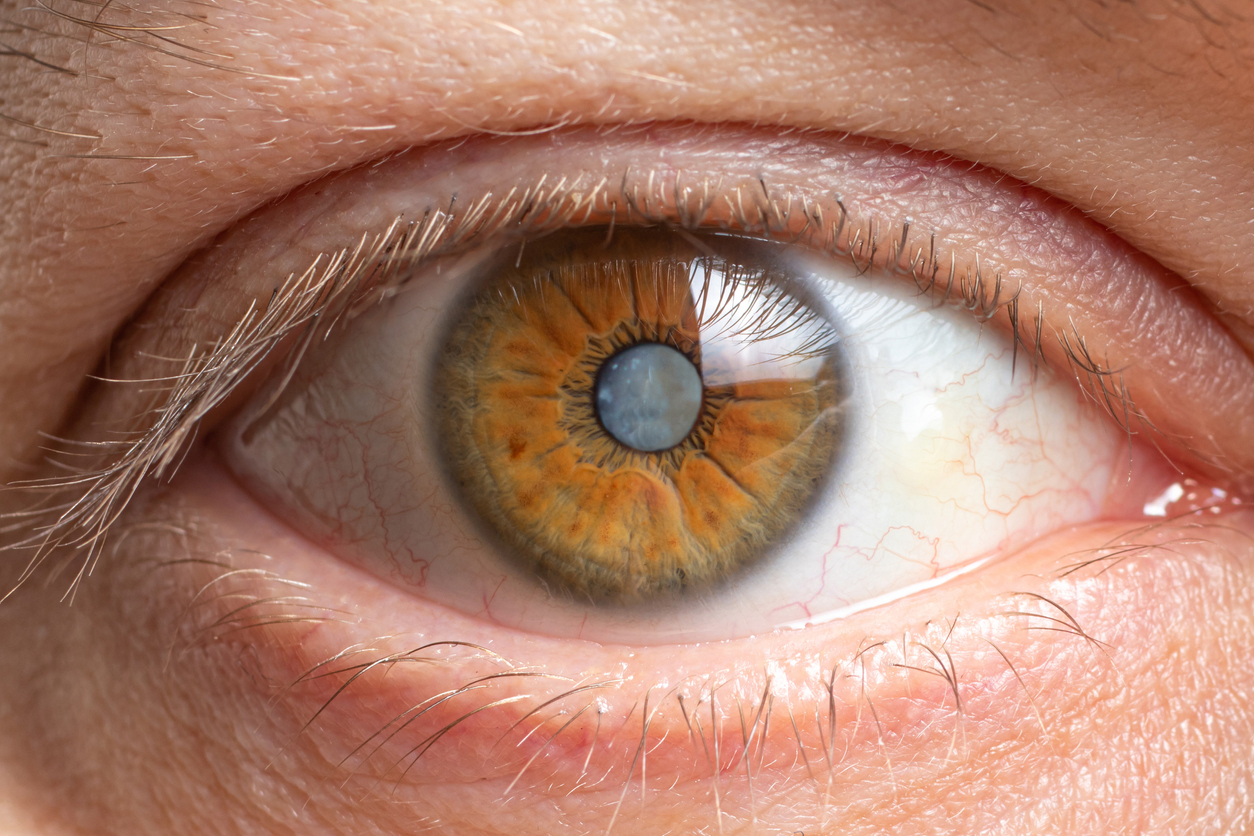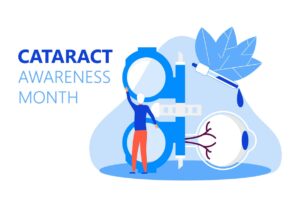
Cataracts, a common condition, cloud the eye’s lens, blurring vision and, if left untreated, may cause blindness. They contribute to more than half of all cases of vision loss globally. It’s a health condition that can disrupt daily life, causing everything from minor inconveniences when reading or driving to more severe struggles like difficulty recognizing faces or coping with light glare. Creating awareness and understanding the importance of eye health becomes crucial. This is precisely what Cataract Awareness Month strives to achieve!
As we delve deeper into Cataract Awareness Month, it becomes more critical to understand the significance of personal eye health and early intervention. Knowledge and awareness can arm you with the tools to spot potential problems and seek early treatment.
Symptoms of Cataracts
Cataracts are a condition that progresses slowly and is typically not painful in its early stages, contributing to why it’s often overlooked or mistaken for normal aging. Despite its quiet onset, recognizing the early signs is pivotal to timely intervention and treatment.
- Blurred Vision: One of the most common symptoms of cataracts is blurred vision. This is often likened to looking through a frosty or fogged-up window. This cloudiness can initially affect a tiny part of the eye’s lens and may not cause noticeable vision loss. However, as the cataract grows, it starts to cloud more of the lens, further distorting light passing through the lens and causing more noticeable blurred vision.
- Seeing Halos around Lights: A distinctive symptom of cataracts is the perception of halos around lights. This can be especially apparent at night when looking at streetlights or oncoming headlights while driving. This occurs as the lens’s clouding diffuses the light that enters your eye, creating a halo-like glow around bright light sources.
- Frequent Changes in Glasses Prescription: People with cataracts might notice frequent changes in their glasses or contact lens prescriptions. They may need stronger glasses, only to quickly become ineffective. Keep in mind that this could be an indication of the development or progression of cataracts.
- Difficulty Seeing at Night: Reduced night vision is another symptom of cataracts. The clouded lens can fail to provide a clear image in low light situations, making it challenging to perform activities like driving at night or in dimly lit spaces.
- Double Vision in One Eye: Finally, some individuals with cataracts experience double vision or diplopia in one eye. This is not the kind of temporary double vision that an eye-muscle imbalance can cause. Instead, double vision remains even when the other eye is closed. This happens when a cataract distorts the light passing through the lens, leading to seeing two images instead of one.
If you have any of these symptoms, please don’t hesitate to visit your eye doctor. Early detection is the best way to prevent further vision loss and maintain eye health.

Risk Factors for Cataracts
Various factors can increase your risk of developing cataracts. By understanding these, you can make informed decisions about lifestyle adjustments to minimize your risks.
- Age: Age is the most significant risk factor for cataracts. Although they can occur at any age, cataracts most commonly affect older adults. According to the American Academy of Ophthalmology, by age 75, approximately half of all Americans have cataracts.
- Smoking: Smoking increases your risk of developing cataracts. The toxins in cigarette smoke can cause oxidative stress and damage the proteins in the lens, leading to the cloudiness characteristic of cataracts. Regular and heavy smokers are more likely to experience cataracts earlier and have a higher degree of vision impairment.
- Diabetes: People with diabetes have a higher risk of developing cataracts. High blood sugar levels can lead to swelling and damage to the eye’s lens, contributing to cataracts. Good diabetes management, therefore, is essential in reducing the risk of cataracts and other eye-related complications.
- Obesity: Obesity is another risk factor associated with cataracts. High body mass index (BMI) is linked to an increased risk of several health conditions, including eye health issues like cataracts. This is thought to be related to metabolic changes and increased oxidative stress that obesity can cause.
- Excessive Alcohol Consumption: Excessive alcohol consumption is a known risk factor for many health conditions, and cataracts are no exception. Regular and heavy alcohol intake can lead to dehydration, nutritional deficiencies, and oxidative stress, which can damage the lens over time and contribute to the formation of cataracts.
- Prolonged Exposure to Sunlight: Finally, prolonged exposure to sunlight, particularly its harmful ultraviolet (UV) rays, can increase the risk of cataracts. UV light can harm the eye’s lens, causing changes that lead to cataract formation. Protecting your eyes from excessive sunlight is crucial by wearing sunglasses with UV protection and a hat or visor in bright sunlight.
While some risk factors, such as age, cannot be controlled, others can be managed through lifestyle changes. Regular eye check-ups are vital to catch the early signs of cataracts and seek timely treatment.
Early Detection for Cataracts
A crucial part of navigating cataracts is to opt for regular eye exams. Optometrists can detect the early formation of cataracts and monitor their growth. Once diagnosed, there are effective treatment options available. One of the most common is cataract surgery, which is safe and highly successful.
Treatment Options for Cataracts
Cataract Surgery
Cataract surgery is the most effective treatment as cataracts worsen and start significantly affecting vision. This procedure involves removing the clouded lens and, in most cases, replacing it with a clear, artificial one called an intraocular lens (IOL).
Multifocal or Extended Depth of Focus Intraocular Lenses (IOLs) offer a game-changing solution for those seeking freedom from glasses or contact lenses. These lenses provide clear vision at various distances, eliminating or significantly reducing the need for glasses or contacts. Whether you’re reading a book or enjoying a scenic view, you can experience enhanced visual acuity without the hassle.
Cataract surgery is one of the most commonly performed operations worldwide and has a high success rate. According to the American Society of Cataract and Refractive Surgery (ASCRS), up to 98% of cataract surgeries successfully improve vision.
Cataract surgery is usually performed under local anesthesia as an outpatient procedure, meaning you don’t have to stay in the hospital.
The two main types of cataract surgery are:
- Phacoemulsification: Also known as ultrasound cataract surgery, this is the most common cataract surgery, in which the surgeon makes a small incision in the eye and uses ultrasound waves to break up the cataract, which is then suctioned out.
- Extracapsular Cataract Surgery: Used for advanced cataracts, this procedure involves removing the cloudy lens in one piece. It requires a larger incision than phacoemulsification.
Postoperative Care and Recovery
Recovery from cataract surgery usually takes a few weeks. Following your doctor’s instructions is crucial, including using prescribed eye drops to prevent infection and inflammation and wearing an eye patch or protective shield for a few days after surgery.
Cataract surgery significantly improves vision for most people. However, in some cases, the back of the lens capsule, which is left in place during surgery to support the IOL, can become cloudy. This condition, known as posterior capsule opacification, can be effectively treated with a quick, painless laser.
Embracing the Future of Eye Health
While Cataract Awareness Month is pivotal in shedding light on this pervasive eye condition, the responsibility for eye health extends far beyond it. As a leader in health policy and technology, we believe in empowering individuals with knowledge and tools for their health management.
Remember, cataracts are a preventable cause of vision loss. Taking charge of your eye health today can help secure your vision for tomorrow. If you are struggling with vision loss, don’t delay care. Schedule your appointment with Florida Eye today!


